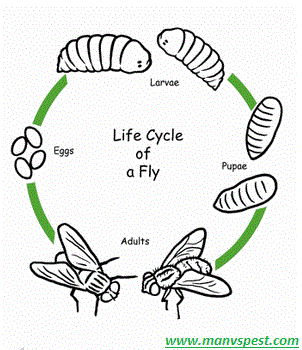Flies exist in several species in all parts of the universe including North America, and their life cycle can range from days to years depending on the conditions and several species. Though, one thing they share in common is that they all undergo the four stages during transformation.
Just like other insects, their transformation begins from egg, larvae, pupa as well as the adult stage.

To know the Every Phase details; Visit here.Since there are different species of flies, their periods of survival do differ as well. For example, the fruit fly stays alive for roughly 30 days after reaching maturity, while the adult housefly can survive up to a period of one month in the wild. However flies can live long in the warmer temperatures and their perfect temperatures are between 75 and 80 degrees mostly those found in American homes.

To learn more about lifespan of a life; Click here

Among the contributing factors, environment plays a significant role in influencing the lifespan flies enjoy. Flies thrive in places of humid air and warm temperatures. With the most favorable climatic regions for them to live to be the subtropical and tropical regions and conversely, in warmer weather conditions, fly growth times cut down together with standard lifespan.
The lifespan of flies is also affected by the lack of accessibility to sufficient food. Flies tend to reside in close vicinity to human beings as well as other animals. They like feeding on feces, garbage along with the residues of organic materials. As it's the only available sources for many fly species.
This is yet another factor that affects the lifespan of flies. Many flies are livelier during the warmer summer period. Equally, throughout winter, flies primarily hibernate. More importantly, warmer temperatures promote more extensive accessibility to food sources, what's more, which hastens to fly metabolic rates furthermore lessens life anticipation.
Hibernation, however, lengthens the lifespan, whereas the insect’s metabolism is quite the opposite since it sluggish down when overwintering. Flies that live in Canada are very lucky because their climate regularly encourages longer fly existence due to the consistently cool temperatures that feature less access to food sources.
Hibernation often widens the lifespan, as the insect's metabolism sluggish down while overwintering. Canadian climates support longer fly life, due to consistently cooler temperatures which feature less admittance to food sources.
There are many different kinds of flies that specialize in particular food sources such as rotting fruit, dead animals and earthworms.
To learn more; Click here
Flies are very small fidgety creatures that happen to annoy people, torment and cause diseases. There are very many types and species of flies with their lifespan ranging from days to even years depending on the species. As discussed in the beginning there are various factors that affect the duration of their survival such as climate, temperature and the availability of food. However, just similar to most of their family, these tiny creatures go through a complex life cycle involving several stages as stated above.